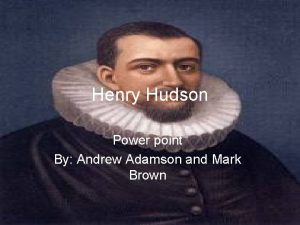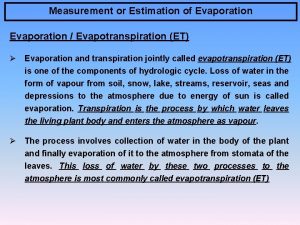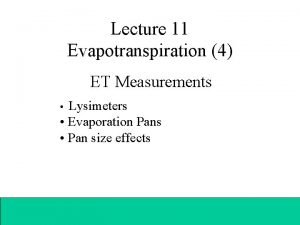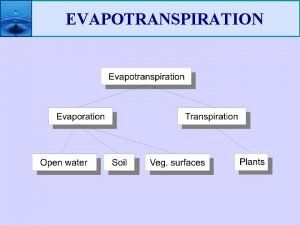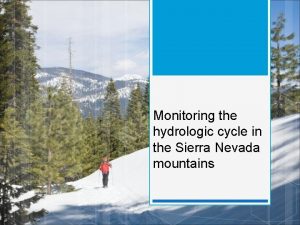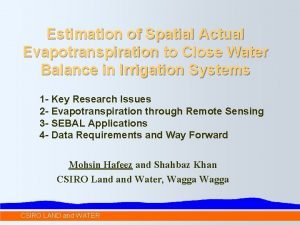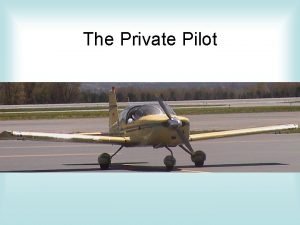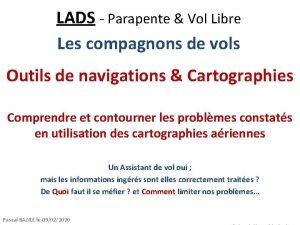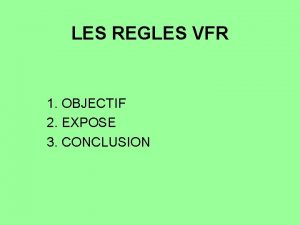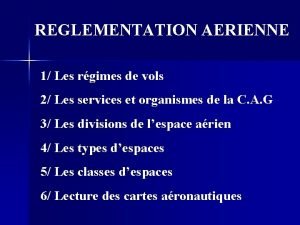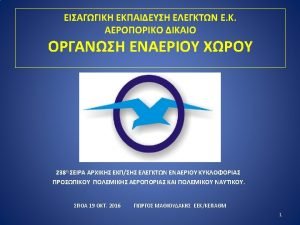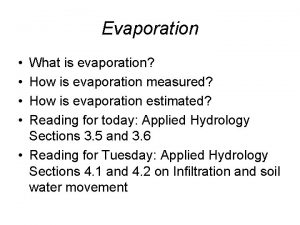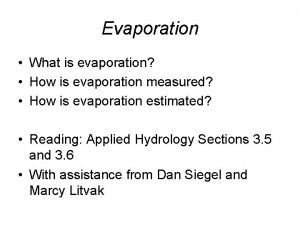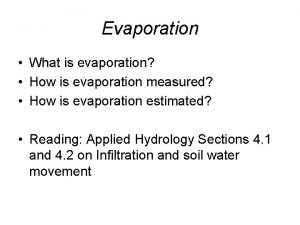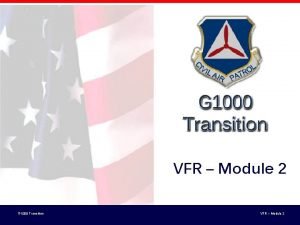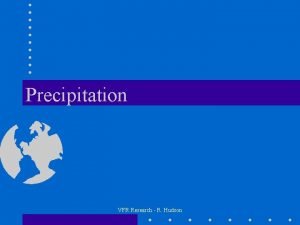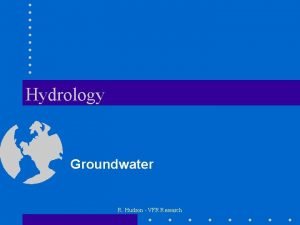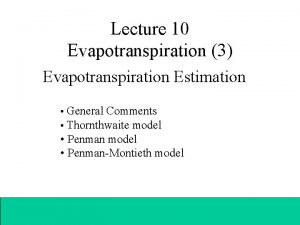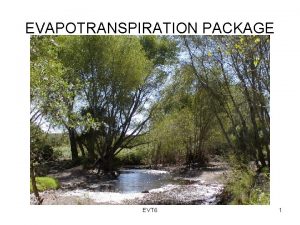Evapotranspiration R Hudson VFR Research Evapotranspiration n Evaporation













- Slides: 13

Evapotranspiration R. Hudson - VFR Research

Evapotranspiration n Evaporation + Transpiration – Evaporation = change of state of water from liquid to vapour, net transfer to the atmosphere. – Transpiration = loss of water vapour from the stomata of plant leaves and replacement in the plant of water extracted from the soil. n Major losses of water from a watershed – Canadian average: 2/3 of ppt is lost to the atmosphere due to evapotranspiration R. Hudson - VFR Research

BC ET rates n In BC, mean annual evaporation varies from about 300 mm in the north to >600 mm in the southern interior and coast – ET ranges from 10 -25% of ppt on coast to as much as 90% of ppt in arid southern interior around the Okanagan. R. Hudson - VFR Research

Energy for ET n An energy balance equation for ET can be written, similar to that for snowmelt: Qn +Qh = QET + Qs + Qq – QET = energy available for ET (contains Qe term) – Qs = sensible heat stored in the atmosphere – Qq = sensible heat stored in biomass n For ET to occur, the following is needed: – a source of water R. Hudson - VFR Research

n Surface or ground water, or water contained in biomass – energy source, principally shortwave radiation, although sensible heat also contributes – vapour pressure gradient – wind n QET is the first priority n PET vs. ET – PET is potential evapotranspiration – ET = PET if not limited by water supply R. Hudson - VFR Research

– When water supply becomes limited, ET<PET n n when this occurs there is a water defecit Measurement of PET, ET – evaporation pans - standard AES method (PE) – lysimeters (PET, ET) – water balance (ET) – empirical formulae R. Hudson - VFR Research

Evaporation pan n Metal cylinder, sits on the ground and is filled with water – AES pan 4’ diameter with 10” sides filled with 8” of water – evaporation measured by monitoring the water level in the pan, usually with a float gauge, corrected for rain input. – Air and water temperature, wind speed are also measured. R. Hudson - VFR Research

– Usually pan evaporation is greater than lake evaporation or ET because of heat input to the sides and base of the pan – a pan coefficient is needed to convert the pan evaporation to ET for the desired vegetation type or to lake evaporation varies seasonally for a given type n range of 0. 3 to 0. 95, average 0. 5 to 0. 8 – there are fewer than 20 AES evaporation pans operating in BC, mostly in the southern part of the province – data from direct measurement needed to develop the pan coefficient. R. Hudson - VFR Research

Direct measurement n Lysimeter – a container is filled with soil on which vegetative cover is maintained, water balance in the container is monitored. – buried in the ground – precipitation input and drainage output are measured – water can be added to the lysimeter (PET) R. Hudson - VFR Research

PET = input - output + change in storage – input = ppt + added water – output = drainage, can be measured at drains in the bottom of the container with a tipping bucket – change in storage: container can be weighed continuously n water table and soil moisture levels can be monitored n – pro: very accurate, can measure ET or PET – con: very expensive and difficult to set up. R. Hudson - VFR Research

Direct measurement n Water balance – can be applied to small research basins – watershed must be water tight - no groundwater leakage – actual ET is back calculated from water balance equation: n ET = precipitation - streamflow – can give basin average ET forested catchments R. Hudson - VFR Research

Empirical methods n Similar to a temperature based snowmelt equation – air temperature is used as a surrogate for radiant energy available for ET – there are many such methods, (e. g. , Blainey. Criddle, Priestly-Taylor, Penman-Monteith), mostly developed for agricultural crops – most common: Thornthwaite - monthly PET R. Hudson - VFR Research

Ta = mean monthly air temperature I = annual heat index b = 0. 49+(0. 0179 I)-(0. 0000771 I 2)+(0. 000000675 I 3) R. Hudson - VFR Research
 Henry hudson fun facts
Henry hudson fun facts Factors affecting evapotranspiration
Factors affecting evapotranspiration Evapotranspiration
Evapotranspiration Evapotranspiration
Evapotranspiration Evapotranspiration
Evapotranspiration Evapotranspiration
Evapotranspiration Evapotranspiration
Evapotranspiration Interpret the weather symbol depicted in utah
Interpret the weather symbol depicted in utah Geoportail oaci vfr
Geoportail oaci vfr Exposé sur vol de nuit
Exposé sur vol de nuit Vfr communications for idiots
Vfr communications for idiots Alerfa incerfa detresfa
Alerfa incerfa detresfa Fir athens
Fir athens Cross country nav log
Cross country nav log
